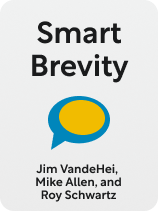

This article is an excerpt from the Shortform book guide to "Smart Brevity" by Jim VandeHei, Mike Allen, and Roy Schwartz. Shortform has the world's best summaries and analyses of books you should be reading.
Like this article? Sign up for a free trial here.
Would you like to make your writing more impactful? Do you want to learn how to communicate your ideas more effectively and keep your readers’ attention?
Smart Brevity by Jim VandeHei, Mike Allen, and Roy Schwartz shares practical advice on tighter writing. The authors recommend using shorter words, active voice, and visual cues to enhance your writing style. These techniques can help you create clearer, more engaging content.
Read on to discover how you can transform your writing and captivate your audience with these simple yet powerful strategies.
Tighten Your Writing Style
Before you can write more clearly and concisely, you need to sharpen how you write. This relates to certain aspects of your writing style. If you want to achieve tighter writing, drop flowery but timid language. Instead, adopt a punchy, to-the-point writing style with strong words, active voice, and visual cues.
The authors advise writers to use shorter, one-syllable words whenever possible, since they’re clearer and more memorable than multisyllable words. For instance, instead of saying that someone “made an illegal withdrawal from a financial institution,” you should write that they “robbed a bank.” Using elaborate words and uncommon terms can confuse the reader. Short, vivid words and phrases that evoke imagery are more memorable and impactful.
(Shortform note: The authors’ advice on writing isn’t new, even if it bears repeating. Many of their rules appeared much earlier in 1918’s The Elements of Style by William Strunk Jr. and E.B. White. In addition to explaining rules of English grammar, Struck and White emphasized clear composition using active voice and positive assertions, and they urged the writer to “omit needless words.” Unlike the authors of Smart Brevity, Strunk and White advised writers not to be too informal and to make their personal feelings invisible. For over a century, The Elements of Style has been a hallmark text on how to write well, and with its focus on brevity and simplicity, it’s a direct ancestor of VandeHei, Allen, and Schwartz’s rules for writing.)
The authors also encourage you to use active voice, which creates a more compelling narrative. “Active” voice is a sentence structure in which the subject of the sentence acts, instead of being acted upon. For example, “Rocky Balboa knocked out Apollo Creed” is more gripping than the passive form: “Apollo Creed was knocked out by Rocky Balboa.” When using active voice, you should also use strong verbs to inject a sense of action and movement into the writing. For instance, don’t write that “Rocky moved quickly up the bleachers”—instead, write that “Rocky ran up the bleachers.”
(Shortform note: Don’t take VandeHei, Allen, and Schwartz’s directive to use the active voice as an absolute rule—there are instances when using passive voice is appropriate. You can use the passive voice when making broad statements about people’s opinions, reporting on actions taken by unknown persons, or when you need to emphasize the action itself or the person acted upon. For instance, in the sentence “Mrs. Jones was snubbed by her neighborhood association,” the passive voice is used to put the focus on Mrs. Jones instead of her neighbors. The passive voice is often discouraged due to its impersonal nature and how it makes sentences less engaging, but that doesn’t mean it should never be used.)
Lastly, to achieve tighter writing, the authors suggest that you employ bullet points, bold text, and images to break up dense paragraphs and make information more accessible. Bolded words or phrases signal to the skimming reader to stop and take note of an important idea. Pictures and bullet points serve a similar function, acting as visual roadblocks that make the reader’s eye pause on crucial bits of data. The goal is to communicate effectively and efficiently using any visual tricks appropriate to your subject without wasting the reader’s time or causing confusion.
(Shortform note: The modern bullet point first entered common usage with the introduction of digital slideshow presentations in the 1980s. Bold typeface appeared much sooner, with examples dating back to the early 1800s, where it was used in public notices and early advertisements to draw attention to important information. However, the use of images with text stretches back to the origins of the written word itself, while the modern use of images to complement printed text started shortly after printing became commonplace in the mid 1400s. Therefore, while we often think of these tools in the digital context that VandeHei, Allen, and Schwartz write about, it’s only their application that’s evolved in the modern era.)

———End of Preview———
Like what you just read? Read the rest of the world's best book summary and analysis of Jim VandeHei, Mike Allen, and Roy Schwartz's "Smart Brevity" at Shortform.
Here's what you'll find in our full Smart Brevity summary:
- How to cut straight to the point to make content engaging
- How clear communication can strengthen your organization
- Why technology has made long-form writing uninteresting






